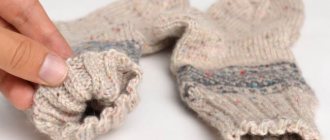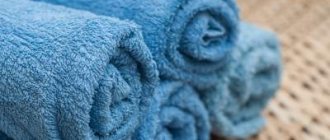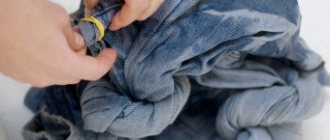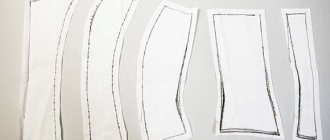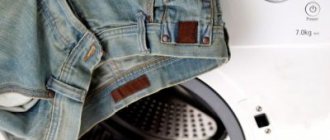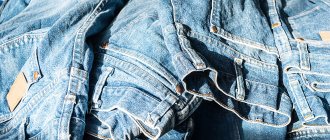We do procedures to make jeans soft
How to make jeans soft without washing?
You just need to space them out well. Dense denim fibers are created stronger than many others with the intent to last longer, be used more often and not be subject to damage from mechanical factors. As everyone knows, the uniforms of American workers were made from it, which explains its very high resistance to wear. But it is still possible to weaken it. Here are the important mechanical actions for this purpose:
- Constant wear - you need to wear them more often and not just sit, but walk down the street, do housework in them, if denim clothing is not allowed at work. The material will really stretch and soften if you actively use it day after day.
- Cycling is a great way to speed up the process of softening your denim pants. Cycling on the street or on a home exercise machine is effective. This way you can kill two birds with one stone: stretch the fabric and correct the figure.
- Deep lunges, squats, leg swings, knee raises and other procedures. Exercising in jeans will also quickly affect their softness in a positive way.
- Constant washing - hand or machine, with powder and softening conditioner, if there is dirt or just as a warning.
Wear jeans more often, run, jump in them, take walks in the evening and hike long distances. They are made just for vigorous use and everyday wear.
Video material
In this article, we told you how to soften jeans at home. We hope you will wear only high-quality items that will be very comfortable and will not cause you any discomfort.
Home / Care
Denim fabric has high strength and elasticity. Trousers made from this material have not gone out of fashion for several decades. But sometimes you need to stretch your jeans. This applies to pants that have not undergone special treatment of cotton fibers (sanforization). They shrink up to 5-7 cm in length and/or width. This fabric is marked accordingly on the label: Dry denim, RAW or Shrink-to-Fit. Fabric marked “one wash” gives virtually no shrinkage.
Jeans: simplicity, comfort and functionality
In the first half of the 50s of the nineteenth century, a lucky tailor founded his own workshop in the city of San Francisco, in which he began to sew pants for gold miners and other workers. Strauss personally visited the villages of gold miners, finding out the desires of potential clients and improving his own products. The workers were pleased with the way Strauss carried out orders.
Soon the trousers were equipped with belt loops, as well as spacious front and back pockets. For good reliability, Strauss made all seams double. A couple of years later, the seam joints on the pockets were reinforced with iron rivets. Having patented a new type of workwear in the first half of the 70s of the 19th century, Strauss began to choose more material that was suitable for his own products. The choice fell on thick cotton fabric with a diagonal weave. This is how modern jeans came into being.
When the number of people seeking to get rich in the gold mines decreased, jeans went into the general population, becoming everyday clothing for very ordinary people. Interestingly, during the Second World War, comfortable and durable jeans began to be used in the United States Army. They were worn by those who specifically took part in hostilities.
Setting the color of new denim trousers
Before loosening your jeans at home, you need to worry about fixing their color, otherwise you run the risk of damaging them. Before washing your trousers for the first time, you need to soak them for some time in a slightly salted solution of water with the addition of vinegar.
We suggest you familiarize yourself with Silicone grease stain: how and with what to remove it from clothes, floors and linoleum
Important! Do not forget that not all jeans that can currently be purchased on the market or in a brand store can be washed in an automatic machine. And products decorated with appliqués or rhinestones are generally recommended to be washed only by hand.
Securing the color of new denim pants
Before softening jeans at home, you should take care to fix their color, otherwise you risk ruining them. Before washing your trousers for the first time, you need to soak them for some time in a slightly salted solution of water with the addition of vinegar.
Important! Remember that not all jeans that can be purchased today on the market or in a company boutique can be machine washed. And products decorated with appliqués or rhinestones are generally recommended to be washed only by hand.
From the history of jeans
Fashion historians have established that Italian sailors were the first to wear pants made of canvas. This material was widely in demand, was cheap, and products made from it were wear-resistant. Afterwards, such trousers received the name “Jenes”. It is believed that this word comes from the name of the city of Genoa, located in Italy and famous for its canvas.
At the end of the 18th century, a book with samples of textile products was published in France, which showed descriptions of pants that looked like jeans.
In the mid-19th century, the Belgian Leiba Strauss arrived in America, whom the sailors immediately dubbed Levi Strauss (in English this name sounds like Levi Strauss). The son of a poor tailor, he had very little property with him, including a solid roll of canvas material, from which, upon arriving on American soil, he began to sew tents according to the orders of gold miners in order to somehow feed himself.
https://www.youtube.com/watch?v=onqrky1q7MI
Once a gold miner he knew complained to Strauss that if he had good pants, he could do without a tent, just sleeping under a tree. The enterprising Strauss recalled the tailoring skills passed on to him by his father, and quickly enough sewed good-quality pants from canvas, which he immediately sold to a gold miner for a dollar or less.
The product was a success, so soon Strauss had new customers.
Types and features of denim fabrics
The need to “fit” jeans arises for many reasons:
- A person may suddenly lose weight and, having lost a couple of kilograms, notice that his pants have become too big and hang slightly - and tightening the belt cannot correct the situation.
- Denim contains a high percentage of cotton, so it absorbs moisture well and conducts air. This determines the comfort of the product. However, like any other cotton, during wear the fabric quickly stretches, and there is a desire to reduce the width of the pants.
- It happens that expensive jeans, tried on a hundred times in the store, actually turn out to be too big.
In these situations, you can reduce the product by one size yourself by washing, drying, boiling and other methods of influencing the fabric. If the pants are two or three sizes too big, you will have to take up the needle.
The first jeans were released in the middle of the 19th century. Pants, jackets and shirts sewn from thick, coarse indole-colored cotton were used as work clothes. Today, textile manufacturers produce several types of denim, which differ in production and dyeing technology, appearance, care methods, and price.
- Denim is a high-quality material made from raw materials collected on plantations in Mexico, Barbados and Zimbabwe. The front side of the fabric is blue, the back side is white. Denim jeans cost several thousand, but the quality justifies the price. These pants fit like a glove, clearly hugging the contours of your figure. They can be washed in water heated to 90 degrees, dried in a machine or in the sun - the fabric will only become stronger.
- Jean is a cheap, soft cotton denim of low quality, entirely dyed in one color. Used for sewing budget clothes. The material is difficult to shrink. If the product is washed in hot water, the fabric will become rough and shrink a little, but will soon restore its texture and the pants will stretch again. When shrinking, not only the volume, but also the length of the product will decrease.
- Stretch is an extremely elastic material from which narrow, tight jeans are sewn. The flexibility of the initially rough denim is given by the lycra fibers that make up the weft threads. Stretched stretch pants look unaesthetic. To return the product to its original appearance, you need to wash it in hot water by hand and dry it in the sun.
- Chambray is a light, thin cotton from which summer shirts, dresses, and tunics are sewn. The density of this type of fabric is half that of classic denim. Items made from chambry are short-lived, quickly tear and wear out, and rarely survive until the new season. After washing or boiling, chambry pants shrink greatly in length and width.
Before experimenting with jeans, trying to reduce their size by hand or automatic washing, soaking or boiling, you need to study the composition of the material from which the product is made and the manufacturer's care instructions. You should not check on expensive pants whether they will shrink after washing - this can ruin the product forever.
How to make jeans very soft?
Now let's talk in detail about how to make hard jeans soft. To achieve the result, you must act according to the instructions given:
Important! For the first time after completing the steps, it is better to put on your pants while lying down, due to the fact that they have not yet been worn out. Most likely, at first you will experience discomfort, but there is nothing terrible about this - you need to walk a little in them, squat, bend your knees ten times, and everything will return to normal. For them to become completely obedient, you will have to wait about a week.
How to iron and dry jeans correctly?
You already know how to make jeans soft at home. But you also need to figure out how to preserve this softness for a long time:
- They need to be dried only on horizontal surfaces or by hanging them by the bottom of the legs on a rope.
- It is better to avoid using a specialized floor dryer.
- Immediately after they become dry, do not rush to turn them inside out, since ironing should take place on the reverse side. It's great if they are slightly damp at this point.
Important! To completely remove the dirt from them, you can put them in the freezer for a couple of hours. As a rule, this specific cleaning method can be used to replace a typical wash.
Before the first wash, it is best to soak your jeans in salted water and vinegar. This will help fix the dye and preserve the color of the jeans for a long time. Wash your jeans in the washing machine, approximately doubling the amount of laundry detergent. By the way, it is better not to set the temperature too high, let alone high spin speeds - this can damage the fabric.
Then rinse them thoroughly. Washing will remove some of the tannins that impregnate the fabric. However, not all jeans can be machine washed. If they have rhinestones, appliqués, or other decorations, it is better to wash the jeans by hand. In all circumstances, add more powder than would normally be the case. By the way, when washing by hand, first dissolve the powder in the water mass, and only then put the jeans there.
We suggest you read: How to remove stains from polyester
An additional solution to the problem of how to make jeans soft is to wash them with the addition of baking soda. If you wash your jeans in a washing machine, you need to add soda at the rate of one tablespoon per 5 liters of water. On average, 10 liters of water are poured into the drum of a washing machine.
Under any circumstances, these indicators can be found in the instructions for the washing machine. You don’t have to wash your jeans a second time, but simply soak them in baking soda and leave them for a couple of hours. After that, the jeans need to be rinsed well enough to remove from the fabric the remains of the powder, soda and substances that soaked the fabric during the washing process.
To get soft and comfortable jeans, add a clothes conditioner to the water when rinsing, preferably more than normal. Of course, after one such multi-stage wash (powder, soda, climate control), the jeans will not immediately be soft enough. At least several of these procedures will be required.
To weaken the fabric of your jeans much more, do not let them dry completely; iron the jeans through damp gauze or other thin fabric. In this case, the iron must not be very hot. A hot iron makes the fabric stiff. And finally, jeans must be worn. From body movements, especially if you squat, bend your legs, etc. in jeans, they will also gradually become softer and more comfortable.
How to properly iron and dry jeans?
You already know how to make jeans soft at home. But you should also figure out how to maintain this softness for a long time:
- They should only be dried on horizontal surfaces or by hanging them by the bottom of the legs on a rope.
- It is better to avoid using a special floor dryer.
- Immediately after they dry, do not rush to turn them inside out, because ironing should take place on the wrong side. It is ideal if they are slightly damp at this point.
Important! To completely remove the dirt from them, you can put them in the freezer for several hours. In principle, this unusual cleaning method can replace standard washing.
Sandpaper
To do this, use fine-grain sandpaper. Before processing, jeans are turned inside out. Rub the product with a small piece, the movements should be clear - only back and forth. In the process, pellets appear and hard fibers are knocked out of the fabric. After sanding, the jeans are shaken and turned inside out. If sandpaper is not at hand, a razor, stone, pumice, or blade can replace it. You cannot go through the same place twice.
Sanding thin jeans is prohibited.
Sandpaper
Be careful with sandpaper. It is better not to treat thin jeans using this method; they can be rubbed to holes.
Material softening process:
- Turn your pants inside out.
- Place it on a flat surface, this will make it easier to work with the fabric.
- Take some grit sandpaper and sand the jeans with it. After a few back-and-forth movements, you will see that the cotton fibers have gathered in a bunch. That's how it should be.
- After completing the manipulation, shake the product well.
Sandpaper can be replaced with a pumice stone, scissors, or even a simple razor.
When using all these items, you need to be extremely careful and not be distracted by extraneous matters.
Carefully follow the procedure so as not to make the fabric too thin, otherwise holes will form.
How often should jeans be washed?
As we already know, jeans are made from the most durable and at the same time durable material, which is why they are so popular. They have excellent wear resistance, so it is recommended to wash them after the fourth or fifth wear, requiring daily use. In practical conditions, they are cleaned very rarely.
Sometimes they become hard again after the tenth or even twentieth wash, and this problem, as a rule, can certainly be solved. You can try to loosen them by simply stretching and shaking the product.
Important! If your jeans seem overly starched, you can get rid of this result by steaming or ironing.
We suggest you familiarize yourself with Where to pour liquid powder in an automatic washing machine
How often should you wash your jeans?
As we already know, jeans are made from a fairly durable and at the same time durable material, which is why they are so popular. They have excellent wear resistance, so it is recommended to wash them after the fourth or fifth wear, subject to daily use. In practice, they are cleaned much less often.
Sometimes they become hard again after the tenth or even twentieth wash, and this problem, in principle, can resolve itself. You can try to soften them by simply stretching and shaking the product.
Important! If your jeans seem too starched, you can get rid of this effect by steaming or ironing.
Problem 1: abrasion
Yes, the most famous and least favorite problem (although, what problems can be called favorites?). Very often, the abrasion of certain models of jeans leads to the fact that everything seems to be fine, the jeans look new everywhere... Except for the groin area, where frayed holes are quite likely to appear (if you constantly wear jeans).
In short, in order not to suffer later, choose jeans in brand stores, depending on the protection of the groin area. And don’t say that jeans in brand stores are quite expensive - this is not right. and if it’s time for discounts, you can even buy clothes at a low price.
Problem 2: grease stains
The most annoying situation is that your jeans are still new, and all of a sudden you drip something greasy onto your favorite panties. Today this is not such a problem, but not all jeans lovers know how to get rid of fat stains.
And for this it makes sense to use one of the following methods:
- Petrol. Drizzle gasoline onto the grease stain. Leave it for a while and then wash the panties;
- Stain remover. It’s hard to recommend anything here; there is quite a wide range of such substances on the market today;
- Modern detergents. Vanish somehow helped me (yes, this company gave me my own limousine, and I mercilessly advertise it everywhere and always).
Fabric stretch
If everyday wear cannot soften the hard material, mechanical action comes to the rescue. Before stretching, the jeans are sprayed with clean water from a spray bottle. Wet matter changes its shape and deforms more easily. You can do this yourself with your hands or put it on yourself, sit in a bath with warm water and sometimes stretch your jeans. It is important to remember that this effect is short-term. After washing, the fabric returns to its previous condition.
Washing and drying
It is recommended to do this on the day of purchase to reduce discomfort while wearing in the future. Before the procedure, the item is turned inside out. An increased amount of powder is added to the washing machine or mixed with a detergent that makes the fabric soft. The temperature in the process should not exceed 70 degrees, which will damage the fabric fibers, as will high spin power.
https://www.youtube.com/watch?v=gY9PVYGB1gU
The next wash is carried out without powder, but with 2 tablespoons of soda and fabric softener. The product will not spoil the color and fabric. The procedure is repeated 3-4 times. It is advisable to dry your jeans naturally. If you have a dryer in the house, you should not set the temperature to high, as it causes the fabric to harden. The same rule applies to ironing the product.
